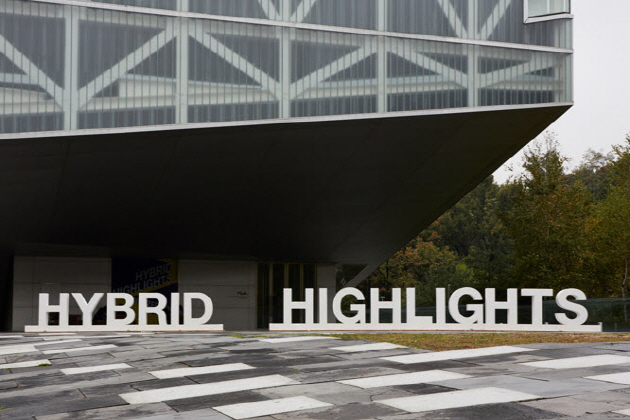
SNU Museum of Art
SNU Museum of Art will be holding the exhibition Hybrid Highlights from October 8 to December 7, 2014. The exhibition is co-hosted by Digital Art Weeks International (DAW Int’l) of the Swiss Federal Institute of Technology in Zurich (ETH Zurich). DAW applies digital technology in the arts. Hybrid Highlights displays 32 installation and digital art pieces by 32 artists from various countries including Canada, Korea, Philippines, and Switzerland.
Exhibition Structure
The three exhibition spaces are committed to different sub-themes. Virtual and augmented reality related works are placed in the core area. The first main exhibition room consists of visualized technology and abstract installations. The final exhibition area has on display games and works interpreting the unrealized.
Virtual Reality
The virtual reality projects aesthetically visualize what the viewers do not expect to see in a visual way. The visual experience of the unseen is heightened with the application of technology.
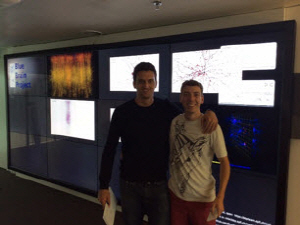
Human Brain Project – EPFL (CHE)
The Human Brain Project, funded by the European Union, aspires to simulate the whole human brain utilizing ICT. The OLED television displays show mesmerizingly vibrant neurons intricately connected in webs, visualizing the most complex structure in this universe. The project signifies that the utilitarian function of technology hybridized with art can bring the unseen into the lives of people, broadening our visual horizon to look beyond what seemingly is reality.
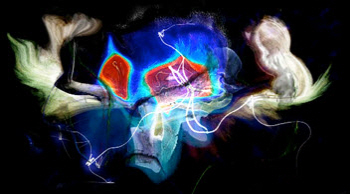
Dynagrams - K-Soul (CHE)
Dynagrams are the first examples of holokinetic painting in art history. Holokinetic painting is moving light painting, which enables the artist to work directly with the light. The computer interface or high-tech canvas records the movements of the electronic brush. Having researched this technique for 15 years, K-Soul is the only artist known to have mastered holokinetic painting. K-Soul believes holokinetic paintings to embody Goethe’s scientific approach – the usage of technology breathes movement and radiation into art.
Visualization
Interactive visualization projects enable viewers to experience another sensory world, while rethinking the concept of being ‘human’ in relation to light, color, and sound.
Project Scriabin reinterprets the human appearance with color and sound. It is an interactive experimentation of the Russian composer Alexander Scriabin’s color scale that accords with the circle of fifths. While Scriabin associated pitch with color, this project employed an opposite mapping direction by corresponding color with pitch.
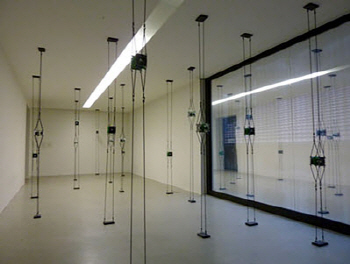
HoerRoom SEOUL – Art Clay (USA, CHE)
The camera sensor reads the viewer, then the program calculates the color value of the person. The viewer’s average color value is converted to a sound. The artwork corresponds to different value systems allowing aesthetic expressions to emerge between different aspects of a person visually and musically.
HoerRoom Seoul is a “point and line to plane” sculpture. The part where sound comes out is the ‘point’ (interactive sound objects), rubber cables are ‘lines,’ and the place they compose is the virtual ‘plane.’ When the viewer pulls the cables back, the ‘point’ is swayed by elasticity which then produces a sound. Each ‘point’ is associated with a different pitch. This installation art defines dimensions of space through its interactions with sound.
Abstract and Irrational
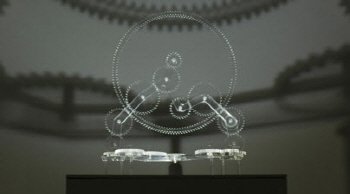
Inside Out by BAE Jae Hyuk
Inside Out is a series of kinetic sculptures depicting the insides of everyday devices. The light shining on the mechanical insides induces shadows on the wall. This enlargement effect allows the viewers to notice what is not usually seen. The silently, palely, mechanically moving parts provoke realizations to appreciate the forgotten and neglected forces that make up the machines.
Games as Art
Alongside the installations, games compose the main part of the exhibition. The walls leading up to the gaming center boldly present a quote by the CEO of Game Land, Eric Zimmerman, “Games may never look like art as we know it because they are simply different than the masterpiece model of the work of fine art.”
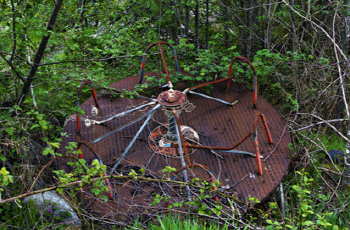
The Watcher - Turtle Cream (KOR)
Two types of games contradict one another as a form of art. The first type, represented by OKO, a graphic puzzle, is the player interventionist model. The player manipulates a series of rotating circular sections to reconstruct a satellite image.
The second type is the non-interventionist model, represented by The Watcher that simulates shy aliens building a UFO on an abandoned merry-go-around. Student docent KIM Tae Young (Dept. of English Language and Literature) found The Watcher most interesting out of all the artworks.
“The game is interesting because from the beginning to the end the player is not allowed to respond. If you respond it will go back to the beginning. If you think of a game, it’s usually an interaction between the player and the game, but it’s so fascinating that we don’t actually play the game; we view the game. So the concept makes the audience reflect on who the real player is. It is also representative of this exhibition as a virtually three-dimensional, interactive art, which challenges the prejudice that art is one-dimensional.”
Seeing the Unseen
Hybrid Highlights brings together trans-disciplinary knowledge and experience to pose interesting questions on the boundary dividing art and science. The exhibition forces viewers to ask whether the works, infused with more technology than aesthetic properties, can be defined as art.
The exhibition also brings technology and art together to notice what we usually do not see, or think about, but have an intimate relationship with. The interactive pieces necessitate the participation of the viewer to complete the artwork, sometimes initiating the actor to experience something beyond the visible environment. Thus, Hybrid Highlights expands the commonsensical view of the world, enabling the viewers to look at the world in a profoundly new way. The conglomeration of the virtual and the real creates a transcendent experience for the visitor in visually encountering the unseen.
SNU MoA is open from Tuesday to Sunday from 10am to 6pm. The entrance fee for visitors from the general public is 3,000 won. Admission is free for all SNU students, staff, and faculty members.
Written by BAE Su Hyen, SNU English Editor, suhyenbae@snu.ac.kr
Reviewed by Eli Park Sorensen, SNU Professor of Liberal Studies, eps7257@snu.ac.kr
Proofread by Melora Brett Briana Johnson, SNU English Editor, morningcalm2@gmail.com

